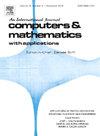A data-driven algorithm for solving image despeckling PDE model using physics-informed ConvNet
IF 2.5
2区 数学
Q1 MATHEMATICS, APPLIED
引用次数: 0
Abstract
In this study, we propose a new data-driven algorithm for the Perona-Malik image despeckling problem. The advantage of the proposed algorithm over neural network-based methods is that it does not need any noisy and clean image data pair for training. The proposed algorithm is implemented using a three-dimensional convolution neural network (ConvNet) architecture. We compare its output with results obtained from several existing methods, including the operator splitting RBF collocation method, the finite difference method (FDM), and physics-informed neural networks (PINNs). To evaluate the performance of the proposed algorithm, simulations are carried out using grayscale images that have been artificially corrupted with different levels of speckle noise. Using the peak signal to noise ratio (PSNR) and structural similarity index measure (SSIM) as the evaluation metric, we observed that the proposed algorithm outperforms these existing methods, demonstrating superior image quality with the same numerical scheme and the same discretization. To the best of our knowledge, this work represents the first application of physics-inspired convolutional neural network for PDE-based image despeckling model.
基于物理信息的卷积神经网络求解图像去斑PDE模型的数据驱动算法
本文针对Perona-Malik图像去斑问题,提出了一种新的数据驱动算法。与基于神经网络的方法相比,该算法的优点是不需要任何噪声和干净的图像数据对进行训练。该算法采用三维卷积神经网络(ConvNet)架构实现。我们将其输出与几种现有方法的结果进行了比较,包括算子分裂RBF配置法、有限差分法(FDM)和物理信息神经网络(pinn)。为了评估所提出的算法的性能,使用被不同程度的散斑噪声人为破坏的灰度图像进行了模拟。采用峰值信噪比(PSNR)和结构相似度指标(SSIM)作为评价指标,我们观察到该算法优于这些现有的方法,在相同的数值格式和相同的离散化下显示出更好的图像质量。据我们所知,这项工作代表了物理启发的卷积神经网络在基于pde的图像去斑模型中的首次应用。
本文章由计算机程序翻译,如有差异,请以英文原文为准。
求助全文
约1分钟内获得全文
求助全文
来源期刊

Computers & Mathematics with Applications
工程技术-计算机:跨学科应用
CiteScore
5.10
自引率
10.30%
发文量
396
审稿时长
9.9 weeks
期刊介绍:
Computers & Mathematics with Applications provides a medium of exchange for those engaged in fields contributing to building successful simulations for science and engineering using Partial Differential Equations (PDEs).
 求助内容:
求助内容: 应助结果提醒方式:
应助结果提醒方式:


